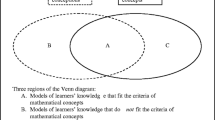Abstract
Lakoff and Nuñez's bookWhere mathematics comes from: How the embodied mind brings mathematics into being (2000) provided many mathematics education researchers with a novel, and perhaps startling perspective on mathematical thinking. However, as evidenced by reviewers' criticisms (Gold,2001; Goldin, 2001; Madden, 2001), their perspective — though liberating for many,with its humanistic emphases — remains controversial. Nonetheless, we believe this perspective deserves further constructive response. In this paper, we propose that several of the book's flaws can be addressed through a more rigorous establishment of conceptual distinctions as well as a more appropriate set of methodological approaches.
Similar content being viewed by others
REFERENCES
Bryant, P. and Squire, A.: 2001, ‘Children's mathematics: Lost and found in space,’ in M. Gattis (ed.), Spatial Schemes and Abstract Thought, The MIT Press, Cambridge, pp. 175-200.
Devlin, K.: 1994, Mathematics: The Science of Patterns, W.H. Freeman, New York.
Dubinsky, E.: 1999, ‘Mathematical reasoning: analogies, metaphors, and images,’ Notices of the AMS46(5), 555-559.
Gelman, R. and Meck, E.: 1983, ‘Preschoolers’ counting: Principles before skill, Cognition13, 343-359.
Gold, B.: 2001, ‘Where mathematics comes from: How the embodied mind brings mathematics into being’, Read this! The MAA Online book review column. Available online at http://www.maa.org/reviews/wheremath.html
Goldin, G.: 2001, ‘Counting on the metaphorical. Where mathematics comes from: How the embodies mind brings mathematics into being,’ Nature413(6851), 18-19.
Madden, J.: 2001, ‘Where mathematics comes from: How the embodied mind brings mathematics into being,’ Notices of the AMS48(10), 1182-1188.
Lakoff, G. and Nuñez, R.: 2000, Where Mathematics Comes From: How the Embodied Mind Brings Mathematics into Being, Basic Books, New York.
Pimm, D.: 1987, Speaking Mathematically: Communication in Mathematics Classrooms, Routledge & Kegan Paul, London.
Poincaré, H.: 1913, The World Foundations of Science, authorised translation by G.B. Halsted, The Science Press, New York.
Pratt, D.: 1998, ‘The co-ordination of meanings for randomness,’ For the Learning of Mathematics18(3), 2-11.
Presmeg, N.: 1992, ‘Prototypes, metaphors, metonymies and imaginative rationality in high school mathematics,’ Educational Studies in Mathematics23, 595-610.
Sfard, A.: 1994, ‘Reification as the birth of metaphor,’ For the Learning of Mathematics14(1), 44-55.
Sierpinska, A.: 1994, Understanding in Mathematics, The Falmer Press, London.
Thurston, W.: 1995, ‘On proof and progress in mathematics,’ For the Learning of Mathematics15(1), 29-37.
Wilson, J.: 1963, Thinking with Concepts, Cambridge University Press, Cambridge.
Wittgenstein, L.: 1953, Philosophical Investigations, in G.E.M. Anscombe (ed.), Blackwell, Oxford.
Author information
Authors and Affiliations
Corresponding author
Rights and permissions
About this article
Cite this article
Sinclair, N., Schiralli, M. A constructive response to `Where mathematics comes from'. Educational Studies in Mathematics 52, 79–91 (2003). https://doi.org/10.1023/A:1023673520853
Issue Date:
DOI: https://doi.org/10.1023/A:1023673520853




